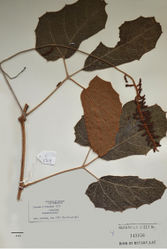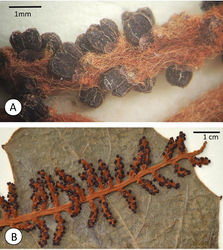Ampelocissus asekii
| Notice: | This page is derived from the original publication listed below, whose author(s) should always be credited. Further contributors may edit and improve the content of this page and, consequently, need to be credited as well (see page history). Any assessment of factual correctness requires a careful review of the original article as well as of subsequent contributions.
If you are uncertain whether your planned contribution is correct or not, we suggest that you use the associated discussion page instead of editing the page directly. This page should be cited as follows (rationale):
Citation formats to copy and paste
BibTeX: @article{Wen2013PhytoKeys21, RIS/ Endnote: TY - JOUR Wikipedia/ Citizendium: <ref name="Wen2013PhytoKeys21">{{Citation See also the citation download page at the journal. |
Ordo: Vitales
Familia: Vitaceae
Genus: Ampelocissus
Name
Ampelocissus asekii J. Wen, R. Kiapranis & M. Lovave sp. nov. – Wikispecies link – IPNI link – Pensoft Profile
Type
Papua New Guinea. Morobe Province: near Haumga, Aseki Patrol area, steep gully in secondary lower montane forest, alt. 4600 ft, liana, leaves glossy mid green above, brownish below, buds dark brown, 6 Apr 1966, L. A. Craven & R. Schodde 1219 (holotype: LAE!, accession number 143956; isotypes: A, CANB, K, L).
Description
Liana. Young stems with dense light-brown woolly hairs. Leaves trifoliate; stipules narrowly triangular, 3–5 mm long, 2–3.5 mm wide; leaflets chartaceous, woolly pubescent with white hairs above, densely rusty woolly pubescent below, base of lateral leaflet strongly oblique, that of terminal leaflet acute, but slightly oblique, apex acute, margin sinuate-spinulose with 3–10 teeth on each side; petiole 9.5–10.5 cm long, densely woolly pubescent; blade of terminal leaflets obovate, blade of lateral leaflets unequally ovate, 13–15 cm long, 6–8 cm wide; lateral veins 5–7 on each side; petiolule 2–3 cm long, densely woolly pubescent. Tendril simple. Inflorescence ca. 35 cm long, a narrow panicle of spikes with all but one branch aggregated on the top 1/3 of the inflorescence primary axis, primary branches ca. 35, each 1–2.8 cm long, light rusty woolly pubescent, each with 6–25 flowers; peduncle ca. 10 cm long. Flowers sessile, 4 to rarely 5-merous; calyx saucer-shaped, glabrous, 0.2–0.3 mm long, 0.5–0.6 mm wide; petals oblong to ovate-oblong, glabrous, 1.0–1.3 mm long, 0.5–0.7 mm wide; floral disc adnate to ovary, grooved; stamens with filaments 0.5–0.6 mm long and ovate-oblong anthers; ovary 2-locular, styles short, 0.2–0.3 mm long. Fruits not seen.
Distribution
The new species is only known from its type locality in Morobe Province, Papua New Guinea.
Ecology
Mid montane forests. Fl. Apr; elevation at ca. 1500 m.
Etymology
This species is named after the type locality, the Aseki Patrol area in Morobe Province.
The new species is closely related to Ampelocissus muelleriana, another endemic from New Guinea. They differ in the highly distinctive brown woolly hairs on the lower leaflet surface, the acute leaflet apex and the chartaceous leaflet texture in the new species (vs. with tufts of rusty hairs in the axils of veins on the lower surface, acuminate leaflet apex, and thin chartaceous to membranaceous leaflet texture in Ampelocissus muelleriana). The new species occurs in the mid montane zone, whereas Ampelocissus muelleriana grows in the lowland rain forests in East Sepik, Madang and Morobe of Papua New Guinea as well as in West Papua of Indonesia.
Ampelocissus arachnoidea is tentatively included in the key.
Original Description
- Wen, J; Kiapranis, R; Lovave, M; 2013: Ampelocissus asekii J. Wen, R. Kiapranis & M. Lovave, a new species of Vitaceae from Papua New Guinea PhytoKeys, 21: 1-5. doi
Images
|


